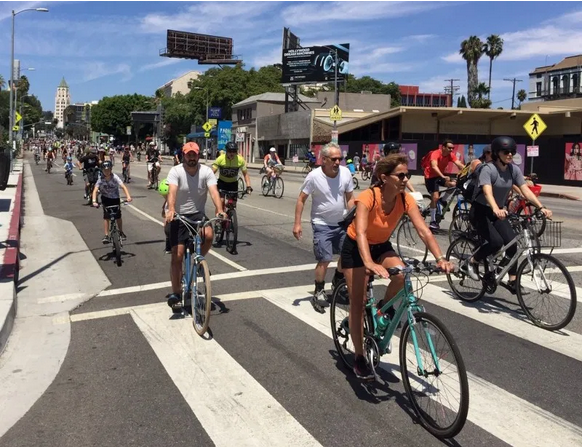With gas prices on the rise, Streetsblog is hearing stories of people trying bicycling for the first time. If you're considering bicycle transportation in L.A., and you haven't done it much, below are a handful of tips to help get you started.
Pick Your Route
Yes, much of L.A. is pretty awful for bicycling... but it does make a big difference what streets and paths you choose. Though most streets don't have bike lanes, in much of L.A. there are quite a few quieter streets which cyclists tend to use.
The fastest, most convenient bike directions are available on Google Maps [website or app]. Like driving or transit, Google Maps generally give you a pretty good cycling route, including how long it will take, and the overall distance. Google Maps also has a layer that shows bikeways - bike lanes, paths, and (near meaningless) bike routes (i.e. streets open to drivers marked by occasional little signs that say "Bike Route"). The bikeway mapping is really useful for the most part, but in some places (including the city of Burbank), Google shows bikeways almost everywhere, including on streets that are not all that comfortable for bicycling.
For more advanced directions, ask a bicyclist. There are lots of little-known neighborhood cut-throughs that Google doesn't always find but that people who bike here know and use. One resource for asking directions from experienced bicyclists is the BikeLA subreddit. Post your question there, and you will get more advice than you ever wanted.
Combine Bike and Transit
It's pretty easy to put your bicycle on Metro. A ten-mile bike ride might not be for most beginners, but a six-mile train ride combined with a couple of miles bicycling on either end can be much easier - and less sweaty. And, for the wonky among us, combining bike with transit offers convenient point-to-point flexibility.
Bikes are free on Metro and Metrolink trains; no reservations needed. Just look for the bike symbol on the train doors and hop on. Do your best to keep your bike from blocking doors and passageways. (Southern California Amtrak trains do take bikes, but require a reservation and a small fee.)
Tip-in-a-tip: bring a bungee cord to keep your bike secure on trains.
There are bike racks on the front of all Metro buses. Pretty much all southern California buses - Foothill Transit, Long Beach Transit, Santa Monica Big Blue Bus, Culver City Bus, etc. - have them. The racks have capacity for just two or three bikes per bus, and spots are first-come, first-served (and fill up quickly on some lines, like ones coming inland from beaches). If you've never put your bike on the bus, watch an instructional video or two - and pay attention to the step by step instructions written out on the racks themselves.
Tip-in-a-tip: if bike racks fill up by your bus stop, try bicycling toward the start of the bus line.
If you're completely unfamiliar with taking transit in L.A., read Metro's how-to page.
Try Metro Bike Share
If you don't want to lug your bike around, or if you want to try cycling before you buy a bike, consider Metro Bike Share. The bike-share system is only available in certain neighborhoods: [view full map] mainly greater downtown L.A. (to USC and much of Hollywood) and the Westside. Most MBS bikes are basic pedal-powered bikes, but there are also pedal-assist e-bikes available. To find e-bikes, look for the lightning bolt icon on the map.
Use the app or kiosk to rent bike-share bikes by the hour, day, week, etc. Bikes must be checked out a docking station and returned to a docking station. Read bike-share how-to instructions at the MBS website. Bike-share combines well with transit.
Lock Bikes Carefully and Securely
Bike thefts takes place all over Southern California. If you're going to bike for transportation, you definitely need to invest in strong lock, which might cost you upwards of 40 or 50 bucks.
If you can, lock your bike where you can see it. If possible, don't leave it on the sidewalk, but bring it in to your work, your park, your restaurant, etc.
The first locking priority is to always secure the bike frame; make sure to put your lock through the frame - not just through a wheel or a seat. (Bike wheels and seats are designed to come off easily and, though thieves do take them and that's a drag, they can be replaced relatively inexpensively). One very good set-up - shown in the SFBC diagram above - is to get a U-lock and a cable - then lock your frame and one wheel with the U-lock and use the cable to secure the other wheel.
Never leave your bike locked on an L.A. street overnight. Generally, only lock on the street when you will be returning within a few hours.
Get an E-Bike
In recent years, electric powered bikes have come a long ways. They come in many different makes/models/flavors... and Streetsblog doesn't claim expertise on telling them apart.
E-bikes are a great solution to avoid paying at the pump. They're excellent for hilly areas, for less intrepid riders, for various trips that are more than a couple of miles, and for transporting everything from groceries to kids.
More Resources
A few online resources for cyclists:
- Streetsblog's list of transit-friendly family-friendly L.A. bikeways
- Streetsblog's list of L.A. City protected bike lanes (as of 2019)
- Biking in L.A. blog
- CiclaValley blog
Some community groups supporting bicycling - many offer classes
- ActiveSGV
- Bicycle Kitchen - volunteer-led community bike shop
- CicLAvia - hosts recurring "open streets" festivals great for safe walking and bicycling
- L.A. County Bicycle Coalition
- People for Mobility Justice






